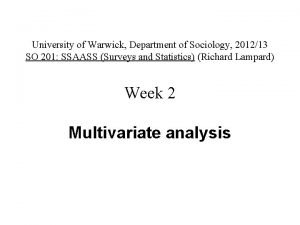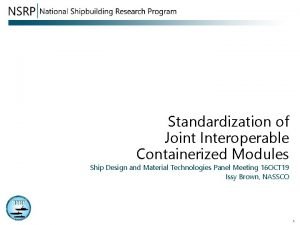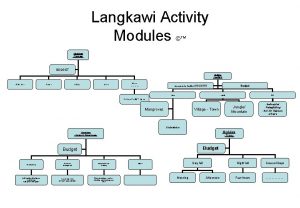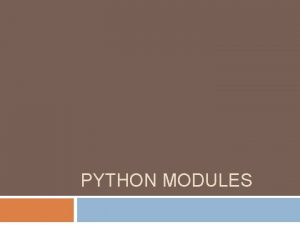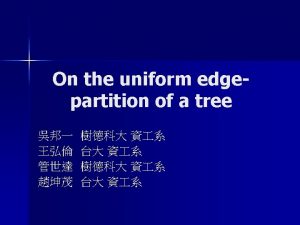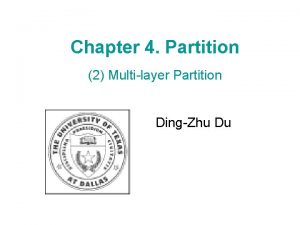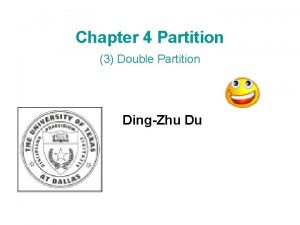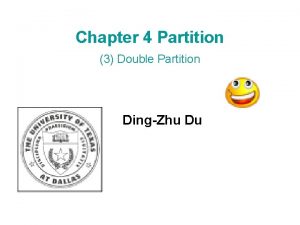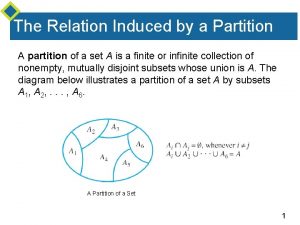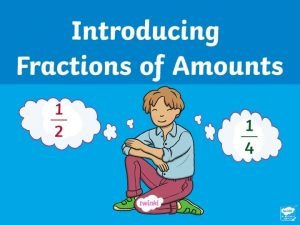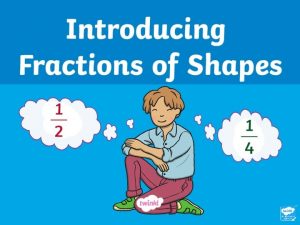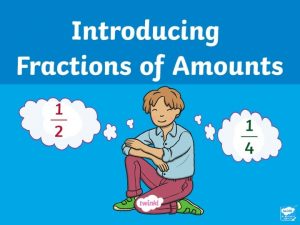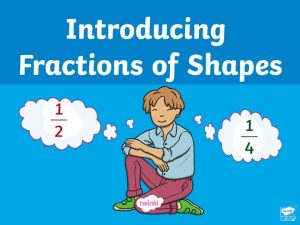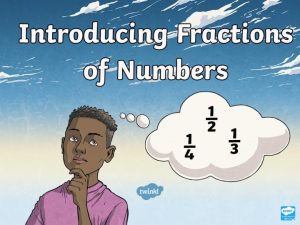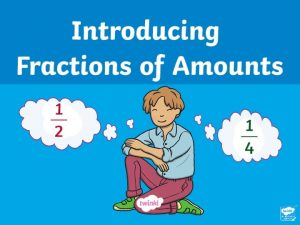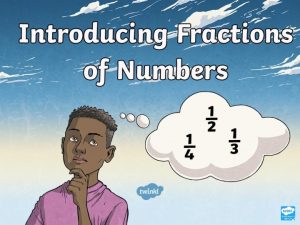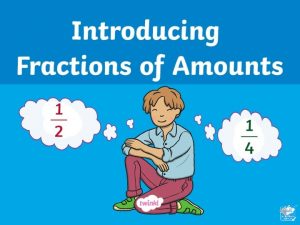Network Partition Network Partition Finding modules of the














































- Slides: 46

Network Partition • Network Partition – Finding modules of the network. • Graph Clustering – Partition graphs according to the connectivity. – Nodes within a cluster is highly connected – Nodes in different clusters are poorly connected.

Applications • It can be applied to regular clustering – Each object is represented as a node – Edges represent the similarity between objects – Chameleon uses graph clustering. • Bioinformatics – Partition genes, proteins • Web pages – Communities discoveries

Challenges • Graph may be large – Large number of nodes – Large number of edges – Unknown number of clusters – Unknown cut-off threshold

Graph Partition • Intuition: – High connected nodes could be in one cluster – Low connected nodes could be in different clusters.

A Partition Method based on Connectivities • Cluster analysis seeks grouping of elements into subsets based on similarity between pairs of elements. • The goal is to find disjoint subsets, called clusters. • Clusters should satisfy two criteria: – Homogeneity – Separation

Introduction • In similarity graph data vertices correspond to elements and edges connect elements with similarity values above some threshold. • Clusters in a graph are highly connected subgraphs. • Main challenges in finding the clusters are: – Large sets of data – Inaccurate and noisy measurements

Important Definitions in Graphs Edge Connectivity: • It is the minimum number of edges whose removal results in a disconnected graph. It is denoted by k(G). • For a graph G, if k(G) = l then G is called an l-connected graph.

Important Definitions in Graphs Example: GRAPH 1 GRAPH 2 A B D C The edge connectivity for the GRAPH 1 is 2. The edge connectivity for the GRAPH 2 is 3.

Important Definitions in Graphs Cut: • A cut in a graph is a set of edges whose removal disconnects the graph. • A minimum cut is a cut with a minimum number of edges. It is denoted by S. • For a non-trivial graph G iff |S| = k(G).

Important Definitions in Graphs Example: GRAPH 1 GRAPH 2 A B D C The min-cut for GRAPH 1 is across the vertex B or D.

Important Definitions in Graphs Distance d(u, v): • The distance d(u, v) between vertices u and v in G is the minimum length of a path joining u and v. • The length of a path is the number of edges in it.

Important Definitions in Graphs Diameter of a connected graph: • It is the longest distance between any two vertices in G. It is denoted by diam(G). Degree of vertex: • Its is the number of edges incident with the vertex v. It is denoted by deg(v). • The minimum degree of a vertex in G is denoted by delta(G).

Important Definitions in Graphs Example: A B D C d(A, D) = 1 d(B, D) = 2 d(A, E) = 2 Diameter of the above graph = 2 deg(A) = 3 deg(B) = 2 deg(E) = 1 Minimum degree of a vertex in G = 1 E

Important Definitions in Graphs Highly connected graph: • For a graph with vertices n > 1 to be highly connected if its edge-connectivity k(G) > n/2. • A highly connected subgraph (HCS) is an induced subgraph H in G such that H is highly connected. • HCS algorithm identifies highly connected subgraphs as clusters.

Important Definitions in Graphs Example: A B Not HCS! D No. of nodes = 5 C E Edge Connectivity = 1

Important Definitions in Graphs Example continued: A B HCS! D No. of nodes = 4 C Edge Connectivity = 3

HCS Algorithm HCS(G(V, E)) begin (H, H’, C) MINCUT(G) if G is highly connected then return (G) else HCS(H) HCS(H’) end if

HCS Algorithm • The procedure MINCUT(G) returns H, H’ and C where C is the minimum cut which separates G into the subgraphs H and H’. • Procedure HCS returns a graph in case it identifies it as a cluster. • Single vertices are not considered clusters and are grouped into singletons set S.

HCS Algorithm Example

HCS Algorithm Example Continued

HCS Algorithm Example Continued Cluster 2 Cluster 1 Cluster 3

HCS Algorithm • The running time of the algorithm is bounded by 2 N*f(n, m). N - number of clusters found f(n, m) – time complexity of computing a minimum cut in a graph with n vertices and m edges • Current fastest deterministic algorithms for finding a minimum cut in an unweighted graph require O(nm) steps.

Properties of HCS Clustering • Diameter of every highly connected graph is at most two. • That is any two vertices are either adjacent or share one or more common neighbors. • This is a strong indication of homogeneity.

Properties of HCS Clustering • Each cluster is at least half as dense as a clique which is another strong indication of homogeneity. • Any non-trivial set split by the algorithm has diameter at least three. • This is a strong indication of the separation property of the solution provided by the HCS algorithm.

Modified HCS Algorithm Example

Modified HCS Algorithm Example – Another possible cut

Modified HCS Algorithm Example – Another possible cut

Modified HCS Algorithm Example – Another possible cut

Modified HCS Algorithm Example – Another possible cut Cluster 1 Cluster 2

Modified HCS Algorithm Iterated HCS: • Choosing different minimum cuts in a graph may result in different number of clusters. • A possible solution is to perform several iterations of the HCS algorithm until no new cluster is found. • The iterated HCS adds another O(n) factor to running time.

Modified HCS Algorithm Singletons adoption: • Elements left as singletons can be adopted by clusters based on similarity to the cluster. • For each singleton element, we compute the number of neighbors it has in each cluster and in the singletons set S. • If the maximum number of neighbors is sufficiently large than by the singletons set S, then the element is adopted by one of the clusters.

Modified HCS Algorithm Removing Low Degree Vertices: • Some iterations of the min-cut algorithm may simply separate a low degree vertex from the rest of the graph. • This is computationally very expensive. • Removing low degree vertices from graph G eliminates such iteration and significantly reduces the running time.

Modified HCS Algorithm HCS_LOOP(G(V, E)) begin for (i = 1 to p) do remove clustered vertices from G H G repeatedly remove all vertices of degree < d(i) from H

Modified HCS Algorithm until(no new cluster is found by the HCS call) do HCS(H) perform singletons adoption remove clustered vertices from H end until end for end

Key features of HCS Algorithm • HCS algorithm was implemented and tested on both simulated and real data and it has given good results. • The algorithm was applied to gene expression data. • On ten different datasets, varying in sizes from 60 to 980 elements with 3 -13 clusters and high noise rate, HCS achieved average Minkowski score below 0. 2.

Key features of HCS Algorithm • In comparison greedy algorithm had an average Minkowski score of 0. 4. Minkowski score: • A clustering solution for a set of n elements can be represented by n x n matrix M. • M(i, j) = 1 if i and j are in the same cluster according to the solution and M(i, j) = 0 otherwise. • If T denotes the matrix of true solution, then Minkowski score of M = ||T-M|| / ||T||

Key features of HCS Algorithm • HCS manifested robustness with respect to higher noise levels. • Next, the algorithm were applied in a blind test to real gene expression data. • It consisted of 2329 elements partitioned into 18 clusters. HCS identified 16 clusters with a score of 0. 71 whereas Greedy got a score of 0. 77.

Key features of HCS Algorithm Comparison of HCS algorithm with Optimal Graph theoretic approach to data clustering

Summary • Clusters are defined as subgraphs with connectivity above half the number of vertices • Elements in the clusters generated by HCS algorithm are homogeneous and elements in different clusters have low similarity values • Possible future improvement includes finding maximal highly connected subgraphs and finding a weighted minimum cut in an edge-weighted graph.

Graph Clustering • Intuition: – High connected nodes could be in one cluster – Low connected nodes could be in different clusters. • Model: – A random walk may start at any node – Starting at node r, if a random walk will reach node t with high probability, then r and t should be clustered together.

Markov Clustering (MCL) • Markov process – The probability that a random will take an edge at node u only depends on u and the given edge. – It does not depend on its previous route. – This assumption simplifies the computation.

MCL • Flow network is used to approximate the partition • There is an initial amount of flow injected into each node. • At each step, a percentage of flow will goes from a node to its neighbors via the outgoing edges.

MCL • Edge Weight – Similarity between two nodes – Considered as the bandwidth or connectivity. – If an edge has higher weight than the other, then more flow will be flown over the edge. – The amount of flow is proportional to the edge weight. – If there is no edge weight, then we can assign the same weight to all edges.

Intuition of MCL • Two natural clusters A B • When the flow reaches the border points, it is likely to return back, then cross the border.

MCL • When the flow reaches A, it has four possible outcomes. – Three back into the cluster, one leak out. – ¾ of flow will return, only ¼ leaks. • Flow will accumulate in the center of a cluster (island). • The border nodes will starve.

Example
 Hình ảnh bộ gõ cơ thể búng tay
Hình ảnh bộ gõ cơ thể búng tay Slidetodoc
Slidetodoc Bổ thể
Bổ thể Tỉ lệ cơ thể trẻ em
Tỉ lệ cơ thể trẻ em Gấu đi như thế nào
Gấu đi như thế nào Chụp tư thế worms-breton
Chụp tư thế worms-breton Chúa sống lại
Chúa sống lại Các môn thể thao bắt đầu bằng từ đua
Các môn thể thao bắt đầu bằng từ đua Thế nào là hệ số cao nhất
Thế nào là hệ số cao nhất Các châu lục và đại dương trên thế giới
Các châu lục và đại dương trên thế giới Công thức tính độ biến thiên đông lượng
Công thức tính độ biến thiên đông lượng Trời xanh đây là của chúng ta thể thơ
Trời xanh đây là của chúng ta thể thơ Mật thư tọa độ 5x5
Mật thư tọa độ 5x5 Làm thế nào để 102-1=99
Làm thế nào để 102-1=99 Phản ứng thế ankan
Phản ứng thế ankan Các châu lục và đại dương trên thế giới
Các châu lục và đại dương trên thế giới Thơ thất ngôn tứ tuyệt đường luật
Thơ thất ngôn tứ tuyệt đường luật Quá trình desamine hóa có thể tạo ra
Quá trình desamine hóa có thể tạo ra Một số thể thơ truyền thống
Một số thể thơ truyền thống Cái miệng xinh xinh thế chỉ nói điều hay thôi
Cái miệng xinh xinh thế chỉ nói điều hay thôi Vẽ hình chiếu vuông góc của vật thể sau
Vẽ hình chiếu vuông góc của vật thể sau Biện pháp chống mỏi cơ
Biện pháp chống mỏi cơ đặc điểm cơ thể của người tối cổ
đặc điểm cơ thể của người tối cổ Ví dụ giọng cùng tên
Ví dụ giọng cùng tên Vẽ hình chiếu đứng bằng cạnh của vật thể
Vẽ hình chiếu đứng bằng cạnh của vật thể Tia chieu sa te
Tia chieu sa te Thẻ vin
Thẻ vin đại từ thay thế
đại từ thay thế điện thế nghỉ
điện thế nghỉ Tư thế ngồi viết
Tư thế ngồi viết Diễn thế sinh thái là
Diễn thế sinh thái là Dot
Dot Số nguyên tố là
Số nguyên tố là Tư thế ngồi viết
Tư thế ngồi viết Lời thề hippocrates
Lời thề hippocrates Thiếu nhi thế giới liên hoan
Thiếu nhi thế giới liên hoan ưu thế lai là gì
ưu thế lai là gì Hổ đẻ mỗi lứa mấy con
Hổ đẻ mỗi lứa mấy con Sự nuôi và dạy con của hổ
Sự nuôi và dạy con của hổ Hệ hô hấp
Hệ hô hấp Từ ngữ thể hiện lòng nhân hậu
Từ ngữ thể hiện lòng nhân hậu Thế nào là mạng điện lắp đặt kiểu nổi
Thế nào là mạng điện lắp đặt kiểu nổi Warwick sociology modules
Warwick sociology modules Nexus 5548 price
Nexus 5548 price Gmp training modules
Gmp training modules Portable accommodation modules
Portable accommodation modules Drupal modules for social networking
Drupal modules for social networking










































